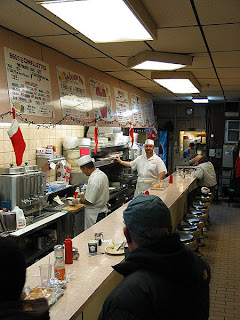 |
| The Nighthawks, 1941, Edward hopper |
Yesterday, an online artist friend and I were having virtual coffee when the conversation strayed from painting to the not totally unrelated topic of diner decor. He described his local burger place as: "White laminated plastic surfaces everywhere, lit by a dreadful combination of cold white fluorescent tubes and unbelievably long neon strips in predominately pale blue with pink accents. The neon makes the place as inviting as an abattoir, (French for slaughterhouse) and as comfortable as a fishmonger's marble slab. The place makes the diner in Hopper's Nighthawks look kinda homey." He concluded by adding contemptuously, "Modern interior design, queen of the arts--Hah! Bring back the Bauhaus." I didn't want to burst his bubble by mentioning it at the time, but much of what he describe from his burger palace was pure Bauhaus. (The Bauhaus, by the way, was a highly influential German school of architecture, painting, interior, and industrial design operating from 1919 to 1933.)
 |
| Bauhaus rectilinear lines and simplicity, replete with neon signage, are evidenced in this 1950s era diner in Hasbrouck Heights, New Jersey |
In the early 1950s, diners (not known as fast food back then) adopted and adapted many Bauhaus design principles to denote a "squeaky clean" efficient look. This was totally at odds with the "greasy spoon" look (and taste) which many lunch spots had at the time, having grown out of the neighborhood bar and grill (not unlike the impressionist hangout, Paris's Cafe Guerbois). For example, in the U.S., we have an institution which men tend to love and women often hate called the White Castle (below). The place is designed to look a little like a white porcelain steel castle, with a small tower, crenelated cornice and all. Inside, the ambiance is a cross between a bus station and an operating room. The burgers are tiny, salty, little squares, paper thin, with minced onion on top, served on cute little square buns (ketchup and mustard to taste). They are about three bites each and known to give you gas big time. And, in spite of what I've just described, they are shamefully delicious. People often consume a dozen at a time. I think Burger King use to have something similar called Burger Buddies.
 |
| Before there was a MacDonalds, before there was Burger King, almost before there was a Bauhaus, there was White Castle. The 5-cent burgers and the architecture date from the early 1920s. |
Though White Castle "architecture" is something of a departure from Bauhaus design, the rationale has something in common: The world is a dark, dirty place, come inside to our pristine, brightness for a quick, healthy (yeah, sure) lunch; and while you're at it, take home a bagful for dinner. The wife and kiddies will love you for it (cold, greasy little hamburgers?...the kids maybe, but the wife?). Believe it or not, in some neighborhoods, these establishments are treated as something akin to an ethnic culinary shrine. And in many neighborhoods, they are a sanctuary of cleanliness and even safety in the midst of poverty, crime, and despair. In Columbus, Ohio, there was an old White Castle in danger of being torn down. The local populace revolted, had a big protest rally, and started petitions. In the end, restaurant was moved a few hundred yards, restored, and even placed on the register of historic structures, which means this dubious architectural masterpiece will be preserved for something like an eternity or longer.
 |
Photo by Daniel Schwen The interior of this modern day Brooklyn, New York, diner is not without Bauhaus influences. |
 |
| However, this New Zealand Burger King may be pushing the Bauhaus 50s thing a bit too far. |
Tidak ada komentar:
Posting Komentar